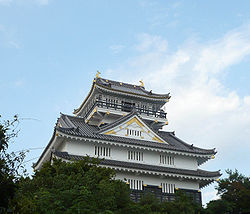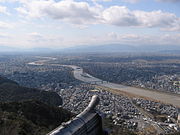| Gifu Castle 岐阜城 | |
|---|---|
| Gifu, Gifu Prefecture, Japan | |
 Gifu Castle | |
| Coordinates | 35°26′02″N 136°46′56″E / 35.43389°N 136.78222°ECoordinates: 35°26′02″N 136°46′56″E / 35.43389°N 136.78222°E |
| Type | Mountaintop castle |
| Site information | |
| Condition | Reconstruction |
| Site history | |
| Built | 1201 |
| Built by | Nikaidō clan |
| In use | 12th–16th centuries |
| Materials |
unknown (original) reinforced concrete (current) |
| Demolished | 1600 |
| Garrison information | |
| Past commanders | Oda Nobunaga |
| Occupants | Saitō clan, Oda clan |
Gifu Castle (岐阜城 Gifu-jō) is a castle located in the city of Gifu, Gifu Prefecture, Japan. Along with Mount Kinka and the Nagara River, it is one of the main symbols of the city.
History[]
Gifu Castle was first built by the Nikaidō clan between 1201 and 1204 during the Kamakura Period.[1][2]
Originally called Inabayama Castle (稲葉山城 Inabayama-jō), Gifu Castle has gone through many numbers of repairs over the course of several generations. Even though it was famous as a physically powerful castle, it was once taken over by a mere sixteen men.
During the Sengoku period a samurai by the name of Takenaka Hanbei went to the castle to visit his sick brother. In reality, he went to the castle not to visit his brother but to kill Saitō Tatsuoki, the lord of castle. When Hanbei struck at him, Tatsuoki was very confused—believing an enemy army had come to attack him—and fled. Thus, Hanbei obtained Inabayama Castle with relative ease.
Later, Hanbei returned the castle to his lord, but Tatsuoki had lost an immeasurable amount of reputation and honor due to his perceived cowardly flight from the castle. When Oda Nobunaga attacked Inabayama Castle, many men under Tatsuoki remembered this event and defected. After easily defeating Tatsuoki, Nobunaga claimed the castle and made it his primary base-of-operations.
Nobunaga renamed the stronghold "Gifu Castle,"[2] following an example set by an ancient Chinese practice. Nobunaga then proceeded to renovate the castle into a far more impressive and grandiose structure than its previous incarnation. Luis Frois, a renowned Jesuit Missionary from Portugal, was personally invited by Nobunaga to visit the castle. After a short stay in Gifu, Frois praised the castle's extraordinary beauty.
The Battle of Gifu Castle in 1600 served as a prelude to both the Battle of Sekigahara and the destruction of Gifu Castle in the same year. After the demolition of the castle, part of the structure was brough to Kanō Castle to the south to fortify its position.[1]
Present day[]

Mount Kinka
The current version of Gifu Castle is a cement structure that was built in the 1950s, as the previous castle had been destroyed by the firebombings of the surrounding city during World War II.[2] Inside the castle, there are three floors with exhibits representing the castle's past.[2] With maps, weapons, pictures and other artifacts on display, visitors can recreate the story of Gifu Castle. On the top floor of the castle, an observation deck,[2] visitors can enjoy a 360-degree panoramic view of the surrounding area, including the Nagara River and Nagoya. At various points throughout the year, the castle is also open to night viewing, providing an awe-inspiring view of the city.[3] The newly opened Gifu City Tower 43 also provides panoramic views of the city and is open late year-round; however, its views are limited to only a few compass directions.
A short walk from the castle is a small archives museum, containing more artifacts from Gifu Castle. Also in this museum are pictures from major castles throughout Japan. Entry into this museum is included in the price to visit Gifu Castle, making it a worthwhile stop for visitors to Gifu Castle. Lights, walkways and signs that were added during 2005's beautification campaign make visiting the castle even more convenient and informative.[4]
Gifu Castle Archives Museum[]
When visitors pay the entrance fee to Gifu Castle, they also receive entrance to the Gifu Castle Archives Museum, located approximately 70 m (230 ft) from the entrance to Gifu Castle. Inside the museum, visitors will find more archives related to Gifu Castle and its past residents. The second floor focuses on musical instruments from Japan's past and present. Additionally, there are pictures of castles throughout Japan adorning the walls of the museum.
Castle operating hours[]

View from the top of Gifu Castle
- Normal Hours
- March 16–May 11: 9:30am to 5:30pm
- May 12–October 16: 8:30am to 5:30pm
- October 17–March 15: 9:30am to 4:30pm
- Night Viewing
- April 28–May 6: until 9:30pm
- July 14–August 31: until 10:00pm
- September 1–October 14: until 9:30pm (Sat., Sun., and holidays only)
- October 15–November 30: until 6:30pm
Access[]

Mount Kinka Ropeway
Mount Kinka offers hiking trails of varying difficulty to Gifu Castle and take approximately one hour.[5] Visitors can also take the Mt. Kinka Ropeway that originates in Gifu Park to the mountain's summit, from which Gifu Castle is just a short walk away.[6]
To get to Gifu Park, you can board buses operated by Gifu Bus at either JR Gifu Station (Bus Platform 11 or 12) or Meitetsu Gifu Station (Bus Platform 4). The bus takes approximately 15 minutes to get to the bus stop for Gifu Park and the Museum of History (Gifu Kōen, Rekishi Hakubutsukan-mae).[7]
References[]
- ↑ 1.0 1.1 Gifu Castle Official Page. (Japanese) Gifu City Hall. Accessed January 11, 2008.
- ↑ 2.0 2.1 2.2 2.3 2.4 Gifu Castle. Japan National Tourist Organization. Accessed May 7, 2008.
- ↑ Gifu City Walking Map. Gifu Lively City Public Corporation, 2007.
- ↑ Outline of Gifu City 2005. Gifu City Hall, April 2005.
- ↑ Mt. Kinka Hiking Trails. (Japanese) Gifu City Hall. Accessed June 12, 2007.
- ↑ Mt. Kinka Ropeway Homepage. (Japanese) Kinkazan Co. Access June 12, 2007
- ↑ Gifu Bus (Noriai Jigyō-bu). (Japanese) Gifu Bus Co., Ltd. Accessed May 7, 2008.
Literature[]
- Schmorleitz, Morton S. (1974). Castles in Japan. Tokyo: Charles E. Tuttle Co.. p. 117. ISBN 0-8048-1102-4.
External links[]
| Wikimedia Commons has media related to Gifu Castle. |
- Gifu Castle Homepage (Japanese)
- Gifu Castle (moving image)
The original article can be found at Gifu Castle and the edit history here.